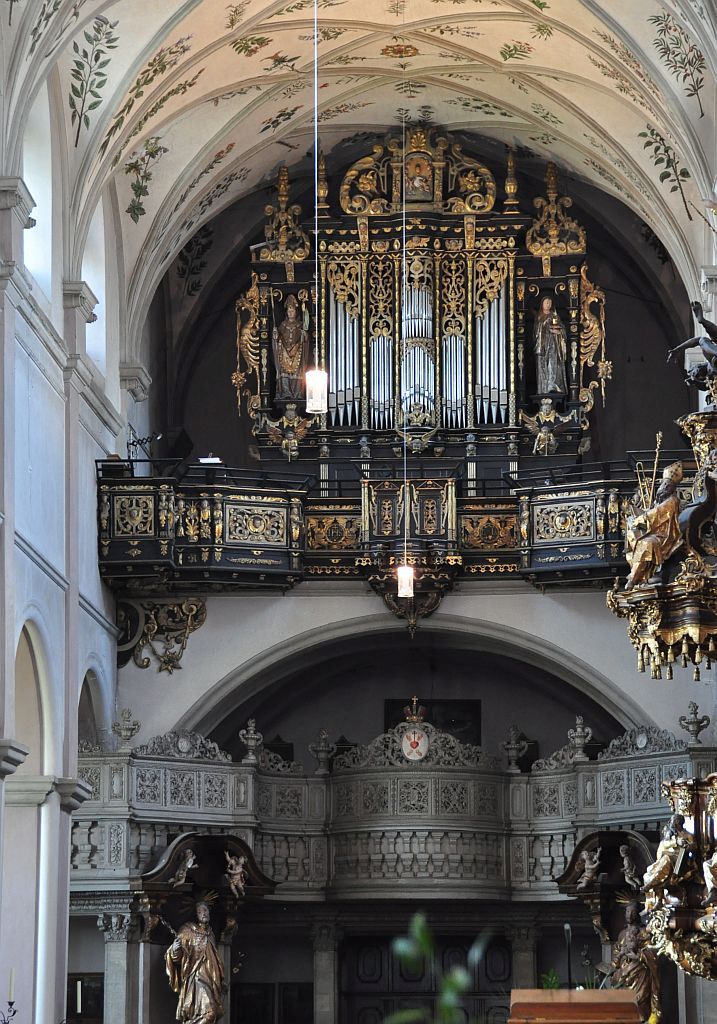Ausführliche Beschreibung der vorgewählten Orgel

Bild: Arno Bekers
Bamberg, Deutschland (Bayern) - Katholische Pfarrkirche Sankt Michael
Gemeinde: Bamberg
Region:Oberfranken
Adresse: Michelsberg 10, 96049, Bamberg
Beschreibung nr.: 2011127.
Gebaut von: Michael Weise (1940) - Opus 458
Die Orgel enthält älteren Material: Organ case aus 1669 von Matthias Tretzscher, Pipework aus 1889 von G.F. Steinmeyer und Co.
Technische Daten
Disposition
Hauptwerk (C-g'''): Quintadena 16', Principal 8' - 1889, Viola 8' - 1889, Gedackt 8' - 1889, Salicional 8' - 1889, Oktav 4' - 1889, Gemshorn 4' - 1889, Quinte 2 2/3' - 1889, Superkctav 2' - 1889, Mixtur 4-5 fach (2'), Trompete 8' - 1889.
Brustwerk (C-g'''): Quintade 8', Rohrflöte 8', Dulciana 8' - 1889, Querflöte 4' - 1889, Blockflöte 2', Spitzquinte 1 1/3', Zymbel 3 fach (1/2'), Krummhorn 8'.
Schwellwerk (C-g'''): Bourdon 16' - 1889, Italienisch Principal 8' - 1889, Lieblich Gedackt 8' - 1889, Dulcianflöte 8' - 1889, Prästant 4' - 1889, Nachthorn 4', Nasard 2 2/3', Schwiegel 2', Terz 1 3/5', Sifflöte 1', Scharff 4-5 fach (1 1/3'), Oboe 8' - from c''' labial, Clairon 4' - from g'' labial, Tremulant.
Pedal (C-f'): Principalbaß 16' - 1889, Violon 16' - 1889, Subbaß 16' - 1889, Sanftbaß 16' - Subbaß low wind pressure, Oktavbaß 8' - 1889, Gedacktbaß 8' - 1889, Choralbaß 4' - 1889, Flachflöte 2', Posaune 16' - 1889.
Koppeln: Hauptwerk - Brustwerk, Hauptwerk - Schwellwerk, Brustwerk - Schwellwerk, Pedal - Hauptwerk, Pedal - Brustwerk, Pedal - Schwellwerk, Oberoktavkoppel Hauptwerk - Schwellwerk, Unteroktavkoppel Hauptwerk - Schwellwerk.
Nebenregister und Spielhilfen: 2 freie Kombinationen, Tutti, Pianopedal zum Brustwerk, Pianopedal zum Schwellwerk, Crescendowalze.

Bild: Arno Bekers
Bamberg, Deutschland (Bayern) - Katholische Pfarrkirche Sankt Michael
Gemeinde: Bamberg
Region:Oberfranken
Adresse: Michelsberg 10, 96049, Bamberg
Beschreibung nr.: 2011127.
Gebaut von: Michael Weise (1940) - Opus 458
Die Orgel enthält älteren Material: Organ case aus 1669 von Matthias Tretzscher, Pipework aus 1889 von G.F. Steinmeyer und Co.
| Jahr | Orgelbauer | Opus | Aktivität | 1669 | Matthias Tretzscher | Neubau | 1729 | Johann Hoffmann | Neubau | 1833 | Justus Karl Hansen | Übersetzung | 1861 | Josef Wiedemann | Restaurierung und Vergrößerung | 1889 | G.F. Steinmeyer und Co. | 384 | Neubau im alten Gehäuse | 1940 | Michael Weise | 458 | Neubau im alten Gehäuse | 1988 | Thomas Eichfelder | Restaurierung |
- The Sankt Michaelkirche in Bamberg was originally an abbey church of the Benedictine monastry in the city. The church burned down on April 27, 1610, including the almost new organ, that had presumably been installed in 1600 by Nikolaus Monsamer. The church was rebuild in the years 1614-1617. The current main organ was built by Matthias Tretzscher in 1669-1670. It is uncertain wether there had been an organ in the church since rebuilt or not. But it's very likely that the organ case that still exists is dating from the construction by Tretzscher, and was manufactured by Johann Brenck. There is no information about the specification of the organ.
- Around 1800, all cloisters were closed during the secularisation. The church of Sankt Michael became redundant and was sold to the city of Bamberg. The church had five organs at the time, inluding the main organ on the west gallery. All instruments were removed from the church and sold, except for the organ case of Tretzscher and the largest of the choir organs. This instrument had been built by Johann Hoffmann in 1728-1729. Karl Hansen installed this instrument in the main organ case in 1832-1833. He enlarged it with a new Principal 8' in the prospect, that was not present in the choir organ. The organ now had nine stops on the manual and three on the pedal. In 1861, Josef Wiedemann carried out a restoration of the organ. He enlarged the manual with a Bordun 16'.
- A entirely new organ was installed in the historic organ cases in 1889 by Steinmeyer, opus 384 of the company. The old Rückpositiv was no in use anymore, and it stayed empty. The new organ was built with mechanical action and cone chests. The instrument was completed in December 1889. The organ had two manuals and pedal with a total number of 28 stops. Consultant during the work as Friedrich Pscherer, who examined the work on December 19, 1889. The instrument was exempt from handing in the front pipes in 1917.
- On the initiative of the organist of the church, Hans Geus, the organ was rebuilt and enlarged in 1939-1940 by Michael Weise. The new design was more in line with the ideas of the Orgelbewegung. A three-manual organ was constructed, partly using the pipework and the windchest of the Großpedal of Steinmeyer, and behind the prospect of Tretzscher. A second console was installed on the choir of the church. The organ was completed in the spring of 1940.
- The Steinmeyer-Weise organ survived the Second World War without problems. In later years many problems occured in the electric system. Those were resolved by disconnecting the second console in 1988 during a renovation by Thomas Eichfelder.
Technische Daten
| Anzahl Register pro Manual | |
| - Hauptwerk | 11 |
| - Brustwerk | 8 |
| - Schwellwerk | 13 |
| - Pedal | 9 (8) |
| Gesamtzahl der Stimmen | 41 (40) |
| Tastentraktur | Electropneumatic |
| Registertraktur | Electropneumatic |
| Windlade(n) | Cone chests |
Disposition
Hauptwerk (C-g'''): Quintadena 16', Principal 8' - 1889, Viola 8' - 1889, Gedackt 8' - 1889, Salicional 8' - 1889, Oktav 4' - 1889, Gemshorn 4' - 1889, Quinte 2 2/3' - 1889, Superkctav 2' - 1889, Mixtur 4-5 fach (2'), Trompete 8' - 1889.
Brustwerk (C-g'''): Quintade 8', Rohrflöte 8', Dulciana 8' - 1889, Querflöte 4' - 1889, Blockflöte 2', Spitzquinte 1 1/3', Zymbel 3 fach (1/2'), Krummhorn 8'.
Schwellwerk (C-g'''): Bourdon 16' - 1889, Italienisch Principal 8' - 1889, Lieblich Gedackt 8' - 1889, Dulcianflöte 8' - 1889, Prästant 4' - 1889, Nachthorn 4', Nasard 2 2/3', Schwiegel 2', Terz 1 3/5', Sifflöte 1', Scharff 4-5 fach (1 1/3'), Oboe 8' - from c''' labial, Clairon 4' - from g'' labial, Tremulant.
Pedal (C-f'): Principalbaß 16' - 1889, Violon 16' - 1889, Subbaß 16' - 1889, Sanftbaß 16' - Subbaß low wind pressure, Oktavbaß 8' - 1889, Gedacktbaß 8' - 1889, Choralbaß 4' - 1889, Flachflöte 2', Posaune 16' - 1889.
Koppeln: Hauptwerk - Brustwerk, Hauptwerk - Schwellwerk, Brustwerk - Schwellwerk, Pedal - Hauptwerk, Pedal - Brustwerk, Pedal - Schwellwerk, Oberoktavkoppel Hauptwerk - Schwellwerk, Unteroktavkoppel Hauptwerk - Schwellwerk.
Nebenregister und Spielhilfen: 2 freie Kombinationen, Tutti, Pianopedal zum Brustwerk, Pianopedal zum Schwellwerk, Crescendowalze.
| Übrige dispositiondaten | |
|---|---|
| Mehrere dispositionen |
|
| Literatur |
|
 |
 |
 |
